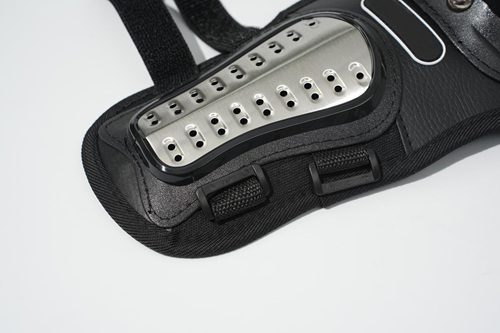Bicycle Knee Protectors–Premium Cycling Safety Gear
What Are Bicycle Knee Protectors?
Bicycle Knee Protectors,also known as cycling knee protectors or bike knee pads,are essential safety gear designed to safeguard your knees during cycling,mountain biking,or other outdoor activities.They provide shock absorption,reduce the risk of injuries from falls or impacts,and ensure a comfortable fit for long rides.Ideal for both professional cyclists and casual riders,these knee protectors combine safety,comfort,and durability.

Material Selection
We carefully select materials to maximize safety and comfort:
Outer Layer:High-impact ABS or nylon for scratch and abrasion resistance.
Padding:High-density EVA foam or gel for shock absorption.
Inner Lining:Soft polyester or mesh fabric for comfort and ventilation.
Straps/Elastic Bands:Adjustable,non-slip materials to keep the pads in place during intense activity.
Application Scenarios
Our bike knee pads are ideal for a variety of users and situations:
Road Cycling&Touring:Protect knees on long rides and uneven terrains.
Mountain Biking&BMX:Absorb shocks during jumps,trails,or downhill rides.
Urban Commuting:Prevent injuries from unexpected falls in city cycling.
Extreme Sports:Suitable for skateboarding,rollerblading,or scooters.
Professional&Amateur Use:Recommended for cycling clubs,training,or casual outdoor activities.
Why Choose Our Bicycle Knee Protectors?
Premium Quality:Materials sourced for durability,comfort,and high-impact protection.
Advanced Ergonomic Design:More comfortable and flexible than standard bike knee pads.
B2B Friendly:Available for bulk orders with customizable options for branding or packaging.
Tested&Certified:Meets international safety standards for sports protective gear.
Customer Support:Responsive support for product inquiries,technical advice,and bulk orders.
By choosing our cycling knee protectors,you gain a reliable partner for high-quality safety gear that stands out from competitors.
FAQ
Q1:Are these bike knee pads suitable for children and adults?
Yes,we offer multiple sizes to fit both adults and kids comfortably.
Q2:Can they be used for other sports besides cycling?
Absolutely.These cycling knee protectors are versatile for mountain biking,skateboarding,rollerblading,and other outdoor activities.
Q3:How do I clean my bicycle knee protectors?
Hand wash with mild soap,rinse thoroughly,and air dry.Avoid machine washing to prevent damage.
Q4:Are they adjustable?
Yes,adjustable straps ensure a secure,comfortable fit for various knee sizes.
Q5:Can I order in bulk for my store or company?
Definitely.We offer bulk pricing and OEM/ODM options for B2B clients.